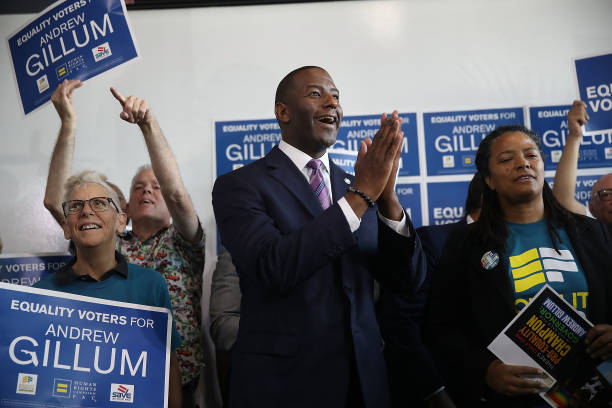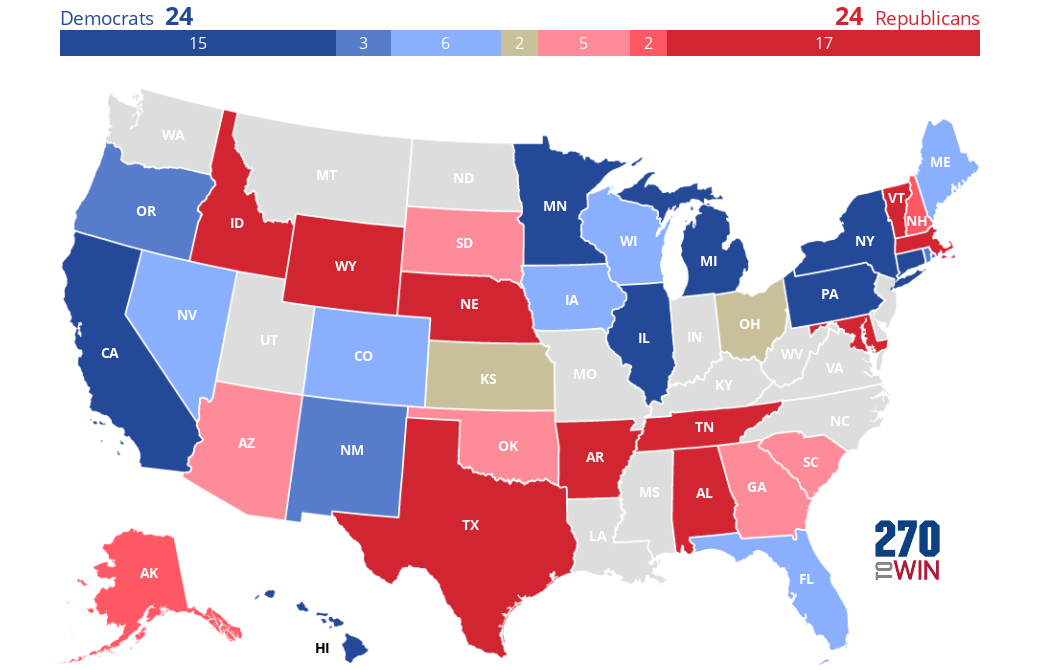
Previously we took an initial look at the 2018 races for Governor across the country, as an update on that article for October, I’m going to review the races again adjusting for any changes in voter sentiment, fundraising, or race dynamics since the initial rankings were released. The short story on 2018’s Gubernatorial races so far is that voter choice and momentum is starting to solidify across the country, and with early voting about to start, there are only a few states that are truly “within” the margins at this point for Democrats and Republicans.
Once again, here are the current rankings (map for reference is above).
Safe GOP (9 seats, no flips)
Idaho (–>from Likely GOP)
Wyoming
Nebraska
Texas
Tennessee (–>From Likely GOP)
Alabama (–>From Likely GOP)
Maryland (–>From Likely GOP)
Vermont
Massachusetts (–>From Likely GOP)
The GOP has locked down a few more holds since the last update. Paulette Jordan’s Democratic campaign in Idaho has seen another round of staff resignations that are a sign she’s on the ropes against Brad Little (R), Dixie Dems Walt Maddox (AL), and Karl Dean (TN), haven’t picked up enough momentum to push the GOP out of the governor’s office, and Northeast moderate Republicans Larry Hogan (MD), and Charlie Baker (MA) are cruising to re-election due to both voter popularity and abysmal campaigns from their Democratic challengers Ben Jealous and Jay Gonzalez. Many Massachusetts voters view Baker as a quasi Democrat (governing a Blue State), while Jealous is seen as a reckless partisan, a label that’s he’s practically embracing at this point.
Likely GOP (2 seats, 1 flip)
Alaska* (–>from Lean GOP)
New Hampshire
Republican Chris Sununu has maintained a consistent lead against Democrat Molly Kelly post-primary, and the lack of push from the DGA or other outside groups here suggests Sununu is going to survive an otherwise tough year for the GOP in the state. Alaska continues to trend GOP as Governor Bill Walker (I) is lagging and has dropped to third place in a three way race featuring Republican Mike Dunleavy and former Democratic Senator Mark Begich. Walker needs to suspend his campaign or Dunleavy is going to flip this seat with less than 50% of the vote.
Lean GOP (5 seats, no flips)
Arizona (–>from toss-up)
South Dakota (<–from Likely GOP)
Oklahoma (–>from toss-up)
Georgia
South Carolina
A mixed bag of changes for the GOP, in Oklahoma it seems businessman Kevin Stitt has has slightly but clearly pulled ahead of Democrat Drew Edmondson, Edmondson is no slouch, but in a red state he may well have hit his ceiling in early polling that was favorable. Stitt’s growing name ID is clearly helping his chances. South Dakota is a surprising trouble spot for the GOP though, Congresswoman Kristi Noem look set to take over but rodeo veteran Billie Sutton (D) has managed to make at least some gains with this rural, conservative electorate. As much as I don’t trust internals, especially from notoriously Dem friendly ALG research, there is probably some truth to the fact Sutton is rising and Noem needs to push harder to close the door on him.
Arizona is a genuine bright spot for the GOP right now, Governor Doug Ducey has rebounded from what looked to be a close race against David Garcia (D), Ducey’s lead seems to be growing and Garcia hasn’t caught fire to the point I’m comfortable moving this race to lean GOP. Garcia needs to step up and find some new angles or he’s going to blow a great pickup chance for Dems.
Nothing appears to be structurally changing in Georgia or South Carolina, we’ll know more once early voting kicks off in these relatively politically stable states. That said, Georgia Democrats know how to waste money, and South Carolina GOP Governor Henry McMaster may benefit from recent Hurricane Relief efforts in the state.
Toss-Up (2 seats)
Kansas
Ohio
These are the two closest governor’s races in America right now, both Laura Kelly (D) and Kris Kobach (R) are stuck between 38%-42% in Kansas, with that race likely to come down to GOTV and turnout modeling. Unsurprisingly, President Donald Trump is headed to Kansas to try to boost his friend Kobach.
In Ohio Democrats are going to win the Senate race, but Democrat Rich Cordray is mired in the muck against Republican Mike DeWine. With Ohio Dems turnout and ground game operation seriously lagging, DeWine still has every shot to save this seat for the GOP.
Safe Dem (8 seats, 2 flips)
Hawaii
California
Minnesota
Illinois*
Michigan*
Pennsylvania
New York
Connecticut
The big story is Dems rise in the Midwest, Illinois, Michigan, and Minnesota look locked down for a party that was down and out in this region for parts of the last decade. GOP Governor Bruce Rauner (Illinois) is more focused on feuding with a third party challenger than actually landing punches against Dem J.B. Pritzker. Republican Bill Schuette is such a disaster for the GOP in Michigan that his poor performance is going to cost the party seats in Congress as well. In Minnesota moderate Democratic Congressman Tim Walz has maintained or grown a solid lead against Republican Jeff Johnson in a state that is already voting.
There has been some noise about a weak showing from Democrat Gavin Newsom in California, but his Republican challenger John Cox is probably going to hit his vote ceiling and lose 60-40 in the end. Connecticut and New York are out of reach for the GOP at this point, and Pennsylvania, a state Trump won, has never been in question this cycle as a Dem hold for Governor Tom Wolf.
Likely Dem (3 seats, 1 flip)
Oregon
New Mexico*
Rhode Island
No changes here, Republicans Knute Buehler (OR), Steve Pearce (NM), and Allan Fung (RI) remain pesky challengers but they don’t have enough momentum to fight off the structural challenges with the electorate that they face right now. Buehler would certainly win in a more GOP friendly year as Oregon Governor Kate Brown is weak.
Lean Dem (6 seats, 5 flips)
Nevada* (<–from toss-up)
Colorado (–>from likely Dem)
Iowa*
Wisconsin*
Florida* (<–from toss-up)
Maine* (<–from toss-up)
These are the states where Dems look set to have a meaningful run of (close) wins in states they have struggled with recently. Nevada has clearly shifted towards Democrat Steve Sisolak, as Republican Adam Laxalt is struggling to build the coalition that got Republican Brian Sandoval into office. Iowa remains leaning towards Dem Fred Hubbell against Republican Governor Kim Reynolds, Tony Evers maintains a credible lead against Governor Scott Walker in Wisconsin, and in Maine outside spending looks set to propel Janet Mills (D) past Republican Shawn Moody.
Florida and Colorado are the most interesting races on this list in terms of recent changes. In Florida, the GOP hasn’t been able to lay a glove on progressive Democrat Andrew Gillum, despite having plenty of things to run on. Republican nominee Ron DeSantis is the worst Republican statewide nominee in Florida since Connie Mack was crushed by Bill Nelson in 2012. His Fox News campaign is alienating all but the most loyal Republican voters and he’s an erratic and unstable candidate who wasn’t ready for primetime.
In Colorado, an accusation that the Dem nominee, Congressman Jared Polis, shoved a female employee has given Republican Walker Stapleton signs of life. However given the current political environment in the state, it’s probably false hope for the GOP.
The current map would give 24 Governorships to the GOP, and 24 to Democrats, with Kansas and Ohio deciding national control of the states, or if they split, leaving the states a 25-25 tie. Right now I would take Kobach and Cordray in their respective states for structural reasons (by narrow margins) resulting in that 25-25 tie.
Main Photo:



 Click the map to create your own at
Click the map to create your own at 







